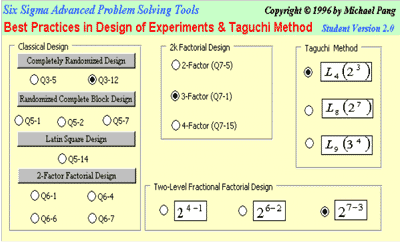| Master the skills to design products and processes
that are robust against variation |
| Introduction |
|
This in-house program will help managers
and engineers select the proper design matrix among
the many DOEs and teach the 15-steps for successful
experimentation. The focus is on how DOE can be used
to gain product and process knowledge quickly, improve
mission-critical quality dimensions, reduce variation,
and create robust products and processes. Topics covered
include: use and benefits of DOE, steps for planning
experiments, design strategies, types of designs and
analysis techniques, choosing the appropriate sample
size, and practical rules of thumb. The program combines
the best of Taguchi and classical DOE strategies and
emphasises a "keep it simple & cost-effective" philosophy
and a structured problem solving approach.
|
| Highlights |
- Best Practices in Design of Experiments
- Factorial design: planning and conducting the experiment,
full-factorial designs, fractional factorial designs
- Experimental analysis: main and interactive effects, experimental
error, ANOVA
- Taguchi designs: orthogonal arrays, analysis and comparison
to factorial designs
- Each participant will be able to plan and design experiments
as well as analyse data, and take timely preventive actions.
- Participants are allowed ample time to discuss how DOE
might be applied in their own work areas.
- Microsoft Excel will be used to perform analysis to show
participants how DOE can be applied for quality improvement.
- Participants will create their own intuitive navigational
DOE and Taguchi software based on Microsoft Excel statistical
library functions and simple VBA macro.
|
| Contents |
- Strategy of Experimentation
- Completely Randomised Design
- Randomised Complete Block Design
- Latin Square Design
- Two-Factor Factorial Design
- 2k Factorial Design
- Two-level Fractional Factorial Designs
- Taguchi Approach to Parameter Design
|
 |
|
|
|
| Program Class Size and Duration and Date |
The class size is capped at 20 participants.
Class of this size ensures maximum learning effectiveness
and quality interaction with the consultant. Selection of
the date for commencement will be mutually agreed upon at
a later period. The program will be held at company’s site.
The total training duration is 40 hours, spread over one month.
|